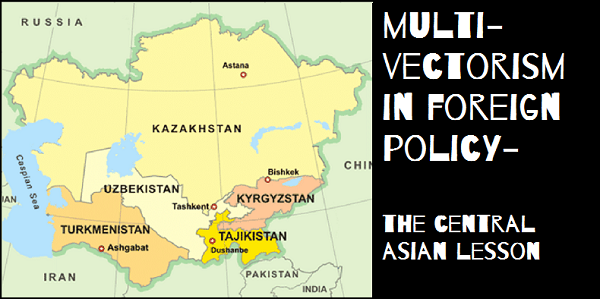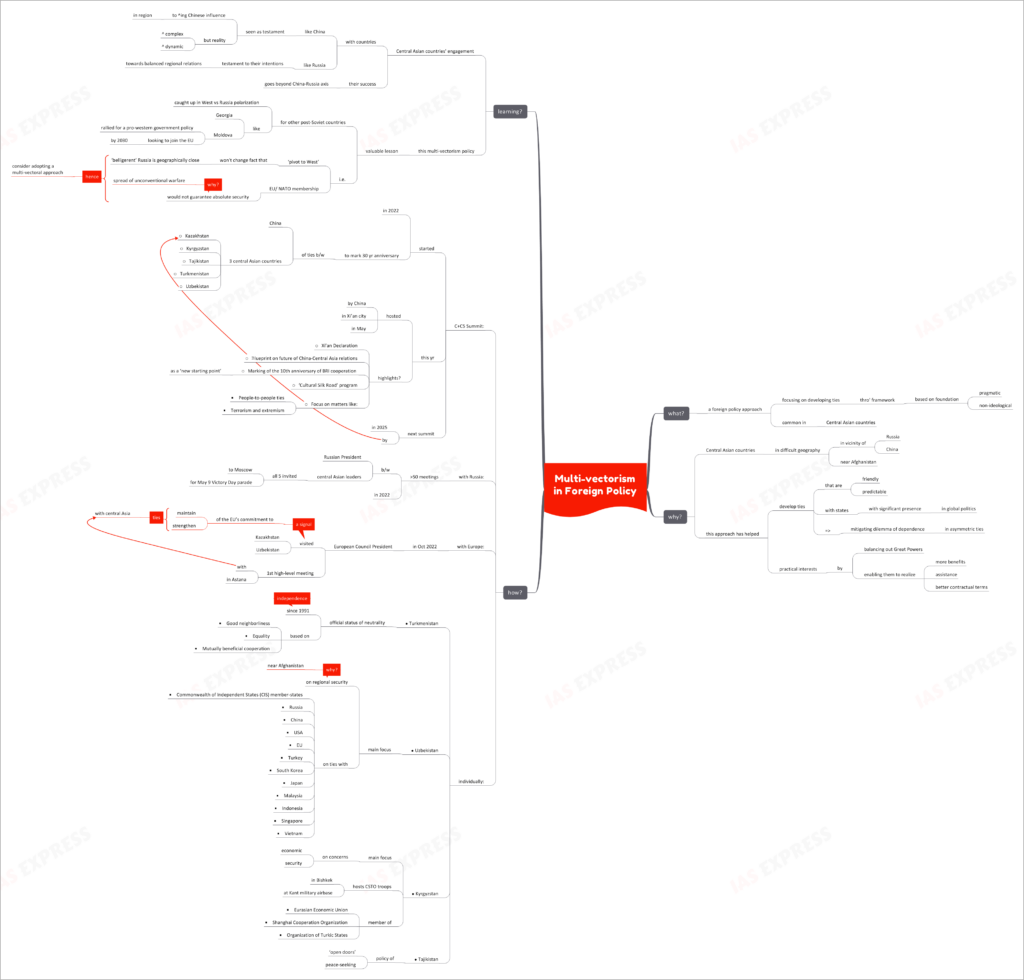Multi-vectorism in Foreign Policy- the Central Asian Lesson

From Current Affairs Notes for UPSC » Editorials & In-depths » This topic
IAS EXPRESS Vs UPSC Prelims 2024: 85+ questions reflected
Given the recent turbulences in Europe, with the West vs Russia polarization becoming increasingly embedded in the region, the Central Asian experience with multi-vectorism could provide valuable insights in designing an appropriate solution.

What is multi-vectorism?
- Multi-vectorism is a foreign policy approach that focuses on developing relations ‘through a framework based on pragmatic, non-ideological foundation.
- This is a common characteristic among the Central Asian countries like Kazakhstan.
Why is it pursued?
- The Central Asian countries are in a geographically difficult position i.e. in the vicinity of big powers like Russia and China.
- The approach has helped it develop friendly and predictable relations with the states that have significant presence in global politics. It has helped mitigate ‘the dilemma of dependence’ in asymmetric relationships.
- It has also been of practical interest to these countries. This has enabled these countries to balance the Great Powers’ influences and realize more benefits, assistances and better contractual terms.
How are the central Asian countries pursuing it?
C+C5 Summit:
- The C+C5 was started to mark 30 years of diplomatic relations (in 2022) between China and the 5 Central Asian countries:
- Kazakhstan
- Kyrgyzstan
- Tajikistan
- Turkmenistan
- Uzbekistan
- This year’s summit was hosted by China in Xi’an city, in May.
- Some of the key highlights:
- Adoption of the Xi’an Declaration
- Adoption of a blueprint on future of China-Central Asia relations
- Marking of the 10th anniversary of BRI cooperation as a ‘new starting point’
- ‘Cultural Silk Road’ program
- Focus on matters like:
- People-to-people ties
- Terrorism and extremism
- The next summit is to be hosted by Kazakhstan in 2025.
Central Asia-Russia engagements:
- According to Carnegie Endowment for International Peace, the Russian President held over 50 meetings with Central Asian leaders in 2022.
- The 5 Central Asian Presidents were invited to Moscow for the May 9 Victory Day parade.
Central Asia-Europe engagements:
- In October 2022, the European Council President visited Kazakhstan and Uzbekistan. This is seen as a political signal of the EU’s commitment to maintain and strengthen ties with central Asia.
- The European Council President also attended the 1st high-level meeting with the Central Asian leaders in Astana.
Central Asian Countries’ Individual Policies:
- Turkmenistan
- Pursuing an official status of ‘neutrality’ since its independence in 1991.
- This policy, according to the official statements, is based on:
- Good neighbourliness
- Equality
- Mutually beneficial cooperation
- Uzbekistan
- Given the precarious situation in Afghanistan, Uzbekistan’s main foreign policy focus is regional security.
- Focus on ties with:
- Commonwealth of Independent States (CIS) member-states
- Russia
- China
- USA
- EU
- Turkey
- South Korea
- Japan
- Malaysia
- Indonesia
- Singapore
- Vietnam
- Kyrgyzstan
- Foreign policy focus on economic and security concerns.
- Bishkek hosts the CSTO (Collective Security Treaty Organization) troops at its Kant military airbase.
- It is also a member of:
- Eurasian Economic Union
- Shanghai Cooperation Organization
- Organization of Turkic States
- Tajikistan
- Pursues a policy of ‘open doors’ and peace-seeking.
- This means it pursues friendly ties with all countries and recognizes shared interests based on equality and reciprocal respect.
What are the learnings?
- While Central Asian countries’ engagement with powers like China can be simply viewed as a testament to growing Chinese influence in the region, the reality is much more complex and dynamic.
- The fact that these former Soviet republics are engaging with Russia is a testament to their intentions towards balanced regional relations.
- The countries’ success with multi-vectorism goes beyond the China-Russia axis.
- In this sense, this policy of multi-vectorism could serve as a valuable lesson for other post-Soviet countries like Georgia and Moldova.
- These countries have been caught up in the recent West vs Russia polarization trend.
- Recently, thousands of Moldovans rallied for a pro-western government policy.
- Moldova is looking to join the EU by 2030 in pursuit of ‘peace and prosperity’.
- However, it must be noted that the ‘pivot to West’ would not change the fact that ‘belligerent’ Russia is geographically close to them. Also, EU/ NATO membership would not guarantee absolute security, given the spread of unconventional warfare.
- In this context, these countries too could consider adopting a multi-vectoral approach to their foreign policy.
- These countries have been caught up in the recent West vs Russia polarization trend.
Conclusion:
Multi-vectorism has served Central Asian foreign policy aspirations to a significant level in the post-Soviet period. Their experience has relevance for the other former Soviet nations that are currently caught up in the current European turbulence.
Practice Question for Mains:
What is multi-vectorism in foreign policy? Explain with reference to Central Asian countries. (250 words)
If you like this post, please share your feedback in the comments section below so that we will upload more posts like this.

